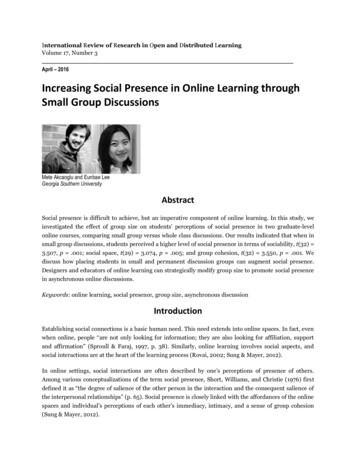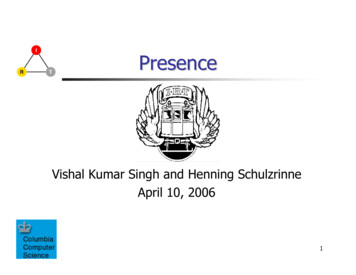
Transcription
International Review of Research in Open and Distributed LearningVolume 17, Number 3April – 2016Increasing Social Presence in Online Learning throughSmall Group DiscussionsMete Akcaoglu and Eunbae LeeGeorgia Southern UniversityAbstractSocial presence is difficult to achieve, but an imperative component of online learning. In this study, weinvestigated the effect of group size on students' perceptions of social presence in two graduate-levelonline courses, comparing small group versus whole class discussions. Our results indicated that when insmall group discussions, students perceived a higher level of social presence in terms of sociability, t(32) 3.507, p .001; social space, t(29) 3.074, p .005; and group cohesion, t(32) 3.550, p .001. Wediscuss how placing students in small and permanent discussion groups can augment social presence.Designers and educators of online learning can strategically modify group size to promote social presencein asynchronous online discussions.Keywords: online learning, social presence, group size, asynchronous discussionIntroductionEstablishing social connections is a basic human need. This need extends into online spaces. In fact, evenwhen online, people ‘‘are not only looking for information; they are also looking for affiliation, supportand affirmation” (Sproull & Faraj, 1997, p. 38). Similarly, online learning involves social aspects, andsocial interactions are at the heart of the learning process (Rovai, 2002; Sung & Mayer, 2012).In online settings, social interactions are often described by one’s perceptions of presence of others.Among various conceptualizations of the term social presence, Short, Williams, and Christie (1976) firstdefined it as “the degree of salience of the other person in the interaction and the consequent salience ofthe interpersonal relationships” (p. 65). Social presence is closely linked with the affordances of the onlinespaces and individual’s perceptions of each other’s immediacy, intimacy, and a sense of group cohesion(Sung & Mayer, 2012).
Increasing Social Presence in Online Learning through Small Group DiscussionsAkcaoglu and LeeSocial presence, the degree of awareness of others in an interaction (Walther, 1992), is an importantaspect of online learning. Research has shown that social interaction is positively linked with learningoutcomes (Gunawardena & Zittle, 1997; Mayer, 2005) and student satisfaction (Borup, West, & Graham,2012; Hackman & Walker, 1990; Richardson & Swan, 2003; Rourke, Anderson, Garrison, & Archer, 1999;Tu, 2002). Social presence also promotes comfort and emotional connections among learners in onlinelearning environments (Aragon, 2003). Perceptions of social presence are influenced by the design andcharacteristics of online learning contexts (i.e., social affordances; Kreijns, Kirschner, Jochems, & vanBuuren, 2007). In other words, some online learning spaces afford more social interactions, andtherefore, are more sociable. In this regard, sociability can be defined as the degree an online learningenvironment can support the creation of an effective social space where learners trust each other and feelconnected with the group.Despite the popular belief that online learning is task focused and isolated, learners in online settings alsoneed social connections (Kreijns et al., 2007; Wickersham & Dooley, 2006). Compared to face-to-facelearning environments, however, online learning has been criticized as less social, lacking social presence(Rovai, 2002) and non-verbal cues (cf. cues filtered out model by Culnan & Markus, 1987). Especially,asynchronous learning environments have been argued to put learners at a disadvantage due to physicalseparation, lack of synchronicity in communication, and text-based nature of the communication(Johnson & Aragorn, 2003; Rovai, 2002; Sung & Mayer, 2012).In text-based asynchronous learning environments, where discussions are designated to be the maincontext for student-student interaction, design issues (e.g., group size) can influence students’participation or perceptions of connectedness with others (Aragorn, 2003). As one of the designconsiderations impacting learners’ experiences in online learning environments, group size is believed tohave a negative impact on group cohesion and student learning (Bertucci, Conte, S. Johnson, & D.Johnson, 2010; Lowry, Roberts, Romano, Cheney, & Hightower, 2006). Researchers have identified that,when in larger groups, students are less engaged in higher-order thinking, produce fewer dialogues, andask fewer questions; discussions are repetitive, and some members may disproportionately dominate thefloor (Hamann, Pollock, & Wilson, 2012). Smaller groups, on the other hand, lead to more opportunitiesfor interactivity and reciprocity and more opportunities for individuals to voice their opinions andcontribute to the discussions (Lowry et al., 2006), and promote a sense of community and cohesion(Rovai, 2002).Previous research has addressed the impact of group size on academic outcomes such as languagelearners’ speaking and writing skills (cf., AbuSeileek, 2012), and critical thinking (Dooley & Wickersham,2007). However, there is a dearth of research on the connection between the group size and socialpresence in online learning. The significance of our research lies on understanding the impact of groupsize on students’ perceptions of social presence in an asynchronous online learning environment. Morespecifically, the purpose of our research was to understand if students’ perceptions regarding social space,group cohesion, and sociability differ depending on the group size in fully online asynchronous learningcontexts.Background2
Increasing Social Presence in Online Learning through Small Group DiscussionsAkcaoglu and LeeGroup SizeThe size of a social group or a team is related to the complexity of its social interactions (Bertucci et al.,2010). Size can be interpreted as the “number of possible relationships in the group by pairs and largersubgroups rather than the number of persons” (Hare, 1962, p. 228). As size increases, the teamworkbecomes more complicated. This complexity introduced by adding more members to a group can beexplained by increasing the number of possible social interactions (Hare, 1962). Bertucci et al. (2010)explain this connection between group size and social interactions as “when individuals work in pairs,however, there are two social interactions (i.e., sending and receiving) to manage. When individuals workin fours, there are 12 social interactions to manage. Thus, the larger the group, the more complex theteamwork, and the longer it may take for a group to be productive and cohesive (Bales & Strodtbeck, 1951;Ortiz, Johnson, & Johnson, 1996)” (p. 258).Group size influences social interaction in groups and teams in several ways. In larger groups, dialoguedecreases when certain speakers emerge and disproportionately dominate (Hamann et al., 2012; Hare,1962). This is also known as social loafing, where an increase in the number of members negativelyimpacts the members’ desire and perceptions of responsibility to put effort toward group’s goals (Bertucciet al., 2010; Lowry et al., 2006). The increased number of individuals in a group may also impact groupmember’s attention negatively. This is because of the attention overload caused by increased amount ofsocial interactions a group member needs to attend with the addition of each new member (Bertucci et al.,2010). Inevitably, this attention overload negatively impacts members’ efforts to complete tasks. Inaddition, when the group size is large, it is harder and slower for the group members to get to know oneanother and develop cohesion necessary for teamwork (Bertucci et al., 2010). This leads to a decline inmorale and communication quality because intimacy between group members, the strength ofinterpersonal relationships, and interactivity and reciprocity remains fairly low (Hare, 1962; Lowry et al.,2006). Finally, according to Lowry et al. (2006), in larger groups, members are more likely to experienceevaluation apprehension (the fear of being criticized by others) and production blocking (suppression ofpossibly good ideas due to engagement with group-related processes, e.g., listening to others).Group size in online learning. In the context of online learning, where learners are limited insocial aspects, there are positive outcomes of being in small learning groups. More specifically, in onlinediscussions, smaller groups are more conducive to making connections among students and promote asense of community (Rovai, 2001; 2002). When placed into discussion groups, information overload andrepetitiveness decrease (Qiu, Hewitt, & Brett, 2014) and the amount of higher-order thinking and learneroutcomes increases (Hamann et al., 2012; Wickersham & Dooley, 2006). In addition, being in smallergroups positively impacts students’ communication experiences in terms of their perceptions of theappropriateness and accuracy of messages and their willingness to participate and interact with others(i.e., openness; Lowry et al., 2006).Furthermore, Qiu et al. (2014) found that although students wrote a greater number of discussion postswhen placed in whole class discussions (15-22 students), students produced the higher quality discussionposts (length and reading level) in small group discussions. The data were especially in support of aconfiguration where small subgroups were created in a large class. Students showed a positive attitude3
Increasing Social Presence in Online Learning through Small Group DiscussionsAkcaoglu and Leetoward small subgroups, wrote more, connected more with each other, and indicated that they felt moreencouraged to talk; this especially affected students from second language backgrounds.In another study, AbuSeileek (2012) found that being in small groups, especially groups of five, positivelyinfluenced language learners’ speaking and listening skills. Compared to groups of six or seven, smallergroups (three, four, five-student groups) had significantly higher achievement in terms of their post-testcommunication skills. It should be noted, however, that although the students collaborated in acomputer-based environment (i.e., students were in a computer lab), this was not an online learningsetting.Dooley and Wickersham (2007) investigated the students’ critical thinking skills as they emerged duringwhole class discussions. The authors identified that when discussions took place in a whole class format,they were often off-topic, certain students dominated the conversation, and critical thinking patterns wereeither disconnected or very weak. Based on these findings, the authors argued that “through the design ofsmaller virtual learning communities, students and instructors in online courses are better able to engagein quality discussions with a high degree of interaction, remain focused and on-topic, and better managethe numerous threads that develop within the forums” (p. 7), a finding iterated by an earlier research bythe authors (Wickersham & Dooley, 2006). Similarly, in another study, Hamann, Pollock, and Wilson(2012) compared the effects of being in a large group versus small group on students’ perceptions ofbenefits of discussions. Their analysis showed that when in smaller groups, students perceived thediscussions to be more conducive to learning and critical thinking.Optimal group size. Findings from prior research (e.g., AbuSeileek, 2012; Lowry et al., 2006;Nielsen & Molich, 1990) provide support and guidance in determining the appropriate group size incommunication contexts. In online learning contexts and possibly in other learning contexts, the generaltendency is that “too few members generate little interactions [sic] and too many members generate asense of being overwhelmed” (Rovai, 2002, p. 5). As noted before, this tendency stems from the fact thatsmall groups support building intimacy, while large groups lead its members to withdraw fromparticipation (Qui et al., 2014).As for a specific group size, Qiu et al. (2014) argue that five is the upper limit for a small group.Supporting the same group size, Hare (1962) also argues that, although optimum size for a group dependson the task, five-person groups can solve problems inherent to smaller and larger groups. Reporting onearlier research, Hare argues that when people are placed into groups smaller than five, they complainthat the group is too small. Nielsen and Molich (1990) also support the argument that five is the optimalnumber of people for evaluation tasks, as beyond five no new information (i.e., identifying errors) isadded. Finally, testing different modes (i.e., face-to-face, computer-mediated communication, and faceto-face with computer support), and different groups sizes (three to six members), Lowry et al. (2006)identified that three-person groups significantly outperform six-person groups, where groups with morethan five members had significant decreases in communication quality. We, therefore, suggest that smallgroups should be composed of three to five members to benefit from the positive outcomes of smallergroup size.Social Presence4
Increasing Social Presence in Online Learning through Small Group DiscussionsAkcaoglu and LeeThe definition of social presence has evolved. Short et al. (1976) defined social presence as “the degree ofsalience of the other person in the interaction and the consequent salience of the interpersonalrelationships” (p. 65). Swan and Shih (2005) emphasized the perception of social presence more than theobjective qualities of the medium.Biocca, Harms, and Burgoon (2003) defined social presence as a “sense of being with another” (p. 456).Lowry’s (2006) definition of social presence expanded to the distant, asynchronous, and digital modes:the degree to which a communication medium allows group members to perceive (sense) theactual presence of the communication participants and the consequent appreciation of aninterpersonal relationship, despite the fact that they are located in different places, that they mayoperate at different times, and that all communication is through digital channels. (p. 633)Kreijns et al. (2007) defined social presence as “the perceived degree of illusion that the other in thecommunication appears to be a real physical person in either an immediate (i.e., real time orsynchronous) or a delayed (i.e., time-deferred or asynchronous) communication episode” (p. 185). Wesituate social presence as one’s perception of interpersonal relationship she or he creates in onlinelearning environments. When students connect with peers and instructors in the learning environment,they perceive social presence in the learning community.Social presence is essential for high quality asynchronous discussion forums. That is, high-quality groupdiscussions entail interaction and reciprocity (Burgoon et al., 2002). When students do not participate ina timely manner or the students’ discussion posts are ignored, it results in limited interaction andreciprocity and low communication quality, and subsequently, students perceive low social presence. Ineffect, it can decrease the quality of student performance (Lowry et al., 2006).Social presence is believed to be composed of certain components (e.g., Biocca et al., 2003). According toKreijns et al. (2007), social presence is influenced by the following factors: sociability (leads to increasesin social interaction), group cohesion (increases in group awareness contributes to perceptions ofpresence), and social space (the social affordances of a learning environment leads to increased socialinteractions). In the following section, we define the three constructs and introduce the hypotheses of thestudy.Sociability. Sociability, contributing to social presence, refers to “a strength or potentialassociated with an environment” (p. 14) for facilitating emergence of social interactions (Kreijns,Kirschner, & Jochems, 2002). Sociability is, therefore, a characteristic of an online learning environmentand can be defined as “the extent to which the environment is perceived to be able to facilitate emergenceof social interactions” (Kreijns et al., 2007, p. 176). Sociable environments enable and facilitate affiliation,interpersonal relationships, trust, respect, satisfaction, social cohesiveness, and good workingrelationships, and cohesion (Kreijns et al., 2002; Kreijns, Kirschner, & Vermeulen, 2013).Several factors determine the sociability of online learning. Social climate, the community of students, therichness of the interaction, benefits and purposes, and support for formal interactions affect perceivedsociability of the learning environment (Gao, Dai, Fan, & Kang, 2010). Additionally, students’ perceptions5
Increasing Social Presence in Online Learning through Small Group DiscussionsAkcaoglu and Leeof their self-representation and their compatibility with the learning environment can also influencesociability of academic or non-academic tasks in a computer-mediated learning environment (Abedin,Daneshgar, & D’Ambra, 2012).Technological affordances are also major determining factors of sociability in online learningenvironments (cf. Gao, Dai, Fan, & Kang, 2010). Design and implementation of technological features canmotivate and sustain socially meaningful interactions and learner satisfaction (Laffey, Lin, & Lin, 2006).As online discussion forums are a technological feature to facilitate interactions among students and, inturn, relationship-building (Yen & Tu, 2011), how to design the discussion forum interactions is animportant instructional decision. However, limited research exists on design decisions on how to enhancesociability of the online environment, particularly with regard to group size. Linking with the impacts ofgroup size in online learning, we hypothesize that the smaller the discussion group sizes, the moresociability students perceive of their online learning environments.oHypothesis 1: Smaller group discussions will lead to higher sociability perceptions.Social space. Social space refers to the “the network of social relationships amongst the groupmembers embedded in group structures of norms and values, rules and roles, beliefs and ideals (Kreijns,Kirschner, Jochems, & Van Buuren, 2004, p. 608). As a construct, social space has a variety ofnomenclature, referred as social climate by Gunawardena and Zittle (1997), social environment by Rourkeet al. (1999), and online atmosphere by Brandon and Hollingshead (1999).Social space is positively influenced by affective aspects of interpersonal relationships in a group, such asgroup cohesiveness, trust, respect, and belonging (Kreijns et al., 2004). Social space, in turn, influencessocial interaction, leading to opportunities for critical dialogue, where open communication is notoffensive or harmful thanks to the trust and sense of community among members. The open flow ofinformation helps increase members’ commitment to group goals and satisfaction with the group (Kreijnset al., 2004). In sum, “a sound social space contributes to a positive social climate/online-atmospherewithin the group (Brandon & Hollingshead, 1999; Rourke, 2000; Rourke & Anderson, 2002)” (Kreijns etal., 2004, p. 608).As constructs of social presence, social space and sociability are moderately correlated (Kreijns et al.,2007). According to Kreijns et al. (2002), low sociability of a group negatively impacts the emergence ofsocial space. In other words, sociability contributes to social space, but the two constructs measuredifferent aspects of the social interactions in groups, as indicated by the moderate level of correlations inprevious research (Kreijns et al., 2007).During asynchronous online discussions, emergence of social space is believed to be influenced by themembers of the community (Kreijns et al., 2013). In other words, the members can decide whether topursue the group's goals, or utilize the affordances of the learning environment (i.e., sociability). Aspectsof social spaces that contribute to social space perceptions is, however, unknown. Especially, we do notknow if group size functions as a social affordance and contributes to social space perceptions duringasynchronous online discussions. Based on previous work on group size, we hypothesize that the smallerthe discussion group sizes, the more positive the students’ perceptions of social space.6
Increasing Social Presence in Online Learning through Small Group DiscussionsAkcaoglu and LeeoHypothesis 2: Smaller group discussions will lead to more positive social space perceptions.Cohesion. Cohesion can be defined as a group’s sense of commitment and closeness with othergroup members (Borup et al., 2012), the we feeling (Qui et al., 2014), and is considered to be a componentof social space (Kreijns et al., 2004). Cohesion indicates the amount of close friends and friendship inpeople’s immediate work environment (Price & Mueller, 1986). Similarly, in an online learning contextlearners are expected to form friendships (Kreijns et al., 2004).Due to the distributed and diverse nature of online learning contexts, researchers were not able to identifybenefits from small group work, contrary to the findings from face-to-face learning contexts (Qui et al.,2014). According to Milliken and Martins (1996), diversity in online settings is one factor that leads tothese negative findings, where diversity arguably leads to dissatisfaction among members and failure toidentify themselves with the group.Design of online learning environments can influence group cohesiveness. For example, accountabilityand interdependence levels can be adjusted to achieve more cohesive groups (Qui et al., 2014). In terms oftechnical aspects (i.e., group size), researchers believe that small groups may negatively impact member’sperceptions of collaboration, by making individual differences among group members more salient.Despite this belief, we contend that in online learning settings, despite the inherent diversity, the learnersare often task focused. We believe by placing individuals into smaller groups, we can reduce negativeaspects of online learning (e.g., social loafing, low levels of group cohesion). As argued by Qiu, Hewitt, andBrett (2014), “many online instructors do not pay enough attention to group size or organization in theircourse planning. Failure to consider group cohesion due to group configuration can lead to unsuccessfulonline discourse” (p. 290). Based on previous work on group size, we hypothesize that the smaller groupdiscussion will positively influence students’ perceptions of group cohesion.oHypothesis 3: Smaller group discussions will lead to increased group cohesion perceptions.The Present StudyDiscussion forums in online courses provide a context for interaction. Especially in graduate level courses,these asynchronous communication tools are used widely. There is limited amount of research in thecontext of online learning examining the relationship between group size and aspects of social presence.In this study, our purpose is to examine the effect of group size on students’ perceptions of social space,group cohesion, and sociability in an asynchronous online discussion environment. More specifically, ourresearch question is: Does the size of online discussion groups influence students’ perceptions of social space, groupcohesion, and sociability?This study carries importance in pointing to instructional design decisions regarding social aspects ofonline learning environments.Methods7
Increasing Social Presence in Online Learning through Small Group DiscussionsAkcaoglu and LeeContext and ParticipantsParticipants in this study (n 33) were graduate students pursuing a master’s degree in education andwere enrolled in a fully online and asynchronous masters course on Assessment and Data Analysis inTeaching at a comprehensive university in the southeastern region of the United States. The data werecollected from two groups of students when the course was offered in two consecutive semesters, Fall2014 (n 17) and Spring 2015 (n 16). Both the content and the instructor of the course remained thesame for the two iterations.InstrumentsThe survey included three instruments: Work Group Cohesion Index (Price & Mueller, 1986), SociabilityScale (Kreijns et al., 2007), and Positive Social Space Scale (Kreijns et al., 2004). The reliability of the fullsurvey (composed of the three subscales) was .974.The Work Group Cohesion Index, developed by Price and Mueller (1986), was used to measureworkgroup cohesion in organizational contexts. The Work Group Cohesion Index consisted of five, 5point Likert scale items (e.g., “To what extent were your group mates friendly?”). The reliability for thissubscale was high, .838.The Sociability Scale (Kreijns et al., 2007) was originally designed to determine the perceived degree ofsociability of computer supported collaborative learning (CSCL) environments (e.g., “This discussionenvironment enables me to develop good work relationships with my team mates”). We adopted this 10item scale to measure the sociability of the asynchronous online text-based discussion environment.While students did not conduct a collaborative project, the scale provided the measure for the functions ofthe learning environment in light of sociability. It was a one-dimensional scale consisting of 10 items.Cronbach’s a for the Sociability Scale revealed a high internal consistency, a 953.The Social Space Scale, developed by Kreijns et al. (2004), was composed of 10 items, designed tomeasure the quality of the social space in asynchronous learning environments (e.g., “We reached a goodunderstanding on how we had to function”). Although the original scale had two dimensions (positive andnegative group behavior), we chose to only include the positive dimension because the items in thenegative scale were not amenable to our learning environment (e.g., “Group members grew to dislikeothers.”). The reliability for this subscale was high, a 947.ProceduresTo give all participants an equal chance of exposure to both the small groups and the large (whole-class)group discussions, the participants were first placed in a whole class discussion for the first part of thesemester (Weeks 1-4). Following this, the participants were randomly placed into permanent groups offour to five members for the following four weeks (Weeks 5-8). During the weekly discussions, theparticipants were required to post their thoughts on reading-related questions that were posed by theinstructor. In addition, students were required to post a response to at least one of their class or groupmate’s original post. Students were graded on the quality of initial posts and the responses.8
Increasing Social Presence in Online Learning through Small Group DiscussionsAkcaoglu and LeeAfter the students experienced both versions of the discussions, an online survey was sent to the studentsstarting Week 9. The survey asked the participants to compare the large group and the small groupimplementations in terms of their perceptions of group cohesion, sociability, and social space (Figure 1).For each survey item the students selected a value (out of 5) to indicate their perceptions of the smallgroup and whole-class implementations separately.Figure 1. Screen capture of the example survey item.Data AnalysisTo understand if the students in the two implementations (i.e., fall and spring semesters) were equivalentin terms of their perceptions, and thus be treated as one sample, we ran independent t tests comparingthe two implementations. The results of the t test indicated that the two implementations did not differ interms of students’ perceptions of the three constructs when placed in a large (i.e., whole class discussions)or a small group (i.e., discussions in a permanent group of four to five members): cohesion: whole class:t(31) .385, p .703; small: t(31) .693, p .493; sociability: whole class: t(31) .385, p .703, small:t(31) .383, p .315; and social space: whole class: t(28) .958, p .346, small: t(28) .806, p .427.Based on this finding, we merged the data from the two implementations and conducted the remainingbetween-subjects analyses (i.e., paired-samples t test) on this combined sample.ResultsSociabilityA statistically significant difference was observed between the small group and large group discussions interms of students’ perceptions of sociability, t(32) 3.507, p .001. As indicated in Table 1, studentsrated sociability higher for the small group discussions (M 4.05, SD .74) than large groups (M 3.65,SD .92). The effect size for the difference was sizable, Cohen’s d .61. This result supported ourhypothesis: students perceived that small discussion groups facilitated higher levels of social interactions.Social SpaceWith regard to social space, there was a statistically significant difference between small and large groupdiscussions, t(29) 3.074, p .005. Small group discussions (M 3.64, SD .74) were perceived to bemore conducive to building positive relationships than whole class discussions (M 3.27, SD .99).There was a medium effect size for the difference, Cohen’s d .56. This result supported our hypothesis:small discussion groups led to more positive perceptions of social space.Cohesion9
Increasing Social Presence in Online Learning through Small Group DiscussionsAkcaoglu and LeeOur results indicated that there was a significant difference in the students’ perceptions of the large andthe small group implementations in terms of group cohesion, t(32) 3.55, p .001. The results indicatedthat students perceived small groups (M 4.06, SD .51) to be more conducive to cohesion than largegroups (M 3.75, SD .65). There was a medium effect size for the difference, Cohen’s d .61. Ourhypothesis was suppo
Mete Akcaoglu and Eunbae Lee Georgia Southern University Abstract Social presence is difficult to achieve, but an imperative component of online learning. In this study, we investigated the effect of group size on students' perceptions of social presence in two graduate-level online courses, comparing small group versus whole class discussions. .










